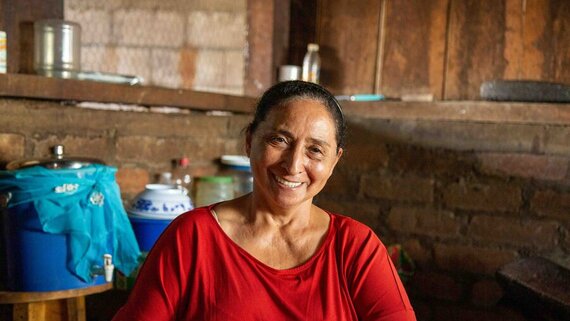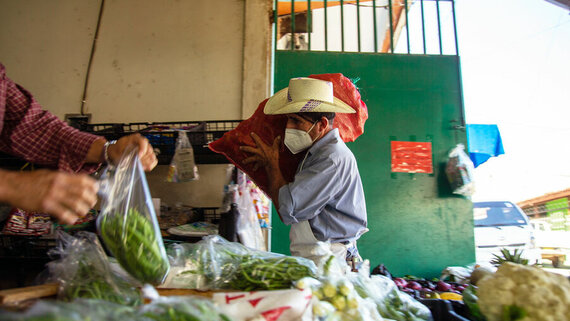Analysis of the context, crisis and needs
El Salvador is among Latin America’s most densely populated countries and faces a diverse array of challenges due to high socio-economic exclusion rates, inadequate urban and infrastructure planning, qualitative and quantitative housing deficits and significant overcrowding. Poverty and food insecurity rates are increasing as purchasing power and livelihoods decrease mainly due to the impact of COVID, further aggravating vulnerabilities and humanitarian need. Approximately 656,000 people live in extreme poverty, representing nearly 10 per cent of the country’s population.
This country is also prone to recurring climate shocks such as droughts, tropical storms and seismic activity, as manifested by the compounded impact of the drought 2018-19, Tropical Storms Amanda and Cristobal, and the Nejapa landslide in 2020. The country suffers from high environmental degradation, making it prone to erosion and landslides.

Cacaopera, El Salvador
Years of recurring droughts and an erratic climate have taken their toll on the Torola River, which courses through the Morazán department, in eastern El Salvador. This woman works as a subsistence farmer and is treasurer of Women with Hope, a cooperative born of the efforts of a group of women who clubbed together to weave and sell hammocks after climate change destroyed their crops. She said: “It is a beautiful river — it used to be very large, it had fish, but now the water’s gone down so much.” Food insecurity in this area is around 2 per cent higher than the national 7 per cent average.
WFP/Nick RoederAmid the COVID-19 pandemic, the loss of employment and the increase in food costs due to supply chain disruptions directly affected the nutritional status and overall health of people, especially vulnerable groups such as children under 5 years of age, pregnant women and the elderly. A combination of negative coping mechanisms along with food shortages led to an increase in the number of food-insecure people. The COVID-19 crisis continues to deepen pre-existing vulnerabilities, including gaps in equitable access to address basic needs such as safe drinking water, and inadequate nutrition and health services, including sexual and reproductive health, protection services and other response services for survivors of gender-based violence (GBV). Existing inequities in education have also deepened, including high dropout rates and lack of education resources, such as access to the Internet and quality education infrastructure.
Crime and other types of violence and insecurity (femicides, infanticides, GBV and violence against children) continue to threaten social development and economic growth. Homicide rates have dropped significantly since 2019, but in 2020 there were 19.8 homicides per 100,000 inhabitants, and a national survey reveals that 63 out of every 100 women interviewed had experienced sexual violence. The prevailing level of insecurity continues to drive high levels of forced internal and cross-border displacements. Salvadorans continue to leave the country seeking international protection, and approximately 38,200 were apprehended at the US border between January and September 2021.
Projected situation in 2022 and beyond
The 2021/2022 Humanitarian Needs Overview identified 1.7 million people in need of humanitarian assistance (25 per cent of the Salvadoran population). This is a staggering 164 per cent increase from the 643,000 people in need identified in 2020, before the COVID-19 pandemic and the impacts of Tropical Storms Amanda and Cristobal multiplied existing vulnerabilities. If left unaddressed, these needs will continue to grow in 2022 and beyond, with severe consequences for the most vulnerable groups.
According to projections from September 2021 to February 2022, close to 600,000 (10 per cent of the population) will experience high levels of acute food insecurity (IPC Phase 3 or above). The situation is expected to deteriorate from March 2022 onwards, when 900,000 (14 per cent of the population) will experience a high level of acute food insecurity entering the lean season for the coming months. This season is characterized by high food prices, low labour opportunities, and the likely continued impact of the COVID-19 pandemic. The presence of La Niña through early spring 2022 threatens to bring heavy rainfall, floods and landslides in parts of the country that would affect the agricultural sector.

Cacaopera, El Salvador
A Salvadoran farmer delivers vegetables to a local market. Cacaopera is situated in the Dry Corridor, a vast stretch of Central America where El Niño-related drought is pushing more people into food insecurity. Farmers in El Salvador are unable to grow crops, which makes food access difficult for millions of people. In a WFP-supported project, three Salvadoran farmers have turned one of their community’s driest strips of land into a green haven, using a type of cultivation that does not require soil and facilitates intensive farming with minimal water.
WFP/Nick RoederIf poverty, low access to food among households and other conditions of deprivation continue or increase, malnutrition in children and pregnant women will rise, leading to long-term consequences, significantly increasing public expenditure on health and negatively affecting national economic performance.
The number of internally displaced people and people at risk of displacement is projected to increase due to growing insecurity and violence, coupled with aggravated socioeconomic conditions. In 2020, 33,200 Salvadorans applied for asylum mainly in Mexico and United States, bringing the overall number of asylum seekers from El Salvador with pending applications to 149,265.
Response priorities in 2022
In 2022, the humanitarian community seeks to assist 912,200 of the most vulnerable people (around 54 per cent of people in need), many of whom have needs related to livelihoods, protection, health, nutrition, education, and basic water and sanitation. The 2021/2022 Humanitarian Response Plan (HRP), requiring US$156 million, aims to protect and save lives through the provision of protection services and access to rights for people with specific needs according to age, gender, diversity and location. Resources were mobilized quickly for food security and protection within the 2021 portion of the 2021/2022 HRP. However, funding for the other eight sectors would ensure a comprehensive response to multidimensional needs.
El Salvador HRP
The strategic objectives and multisectoral response approach aim to provide coordinated and targeted assistance to address critical needs in high-priority areas prone to the impact of disasters and violence. Additionally, the HRP’s actions seek to support and strengthen sustainable solutions through humanitarian-development collaboration to restore essential services and systems, and to strengthen community and institutional resilience.
Further reading
Source: Humanitarian Insight
Source: Financial Tracking Service
Source: Office for the Coordination of Humanitarian Affairs



